Attached files
| file | filename |
|---|---|
| 8-K - 8-K - REGIONS FINANCIAL CORP | rf2017-1103ir.htm |

BancAnalysts
Association of
Boston Fall
Conference
November 3, 2017
Exhibit 99.1

Strategic initiatives
2

2017 YTD Results(1)
Results reflect continued execution of our strategic plan
3
Profitability Balance Sheet andCapital Optimization
Focused on the
Fundamentals
• Net income(2) increased 7%
YTD
• Diluted EPS(2) increased 13%
YTD
• Net interest income and other
financing income (FTE)
increased 4% YTD
• Net interest margin increased
18 bps YTD to 3.31%
• Non-interest expenses
decreased 2% YTD; and the
efficiency ratio improved
130bps
• Disciplined approach to credit
continues to deliver positive
results as we have experienced
improvement in most credit
metrics
• Remain committed to prudently
growing loans while improving
risk-adjusted returns
• Net interest income and other
financing income continues to
benefit from asset sensitive
balance sheet and strong deposit
franchise
• Returned over $1 billion to
shareholders YTD through
dividends and share repurchases
• Plan to eliminate $400 million
in expenses well underway,
expect to achieve majority by
end of 2018; committed to
additional expense reductions
beyond the $400 million,
details provided later this year
• Grew checking accounts,
households, credit cards,
wealth management
relationships, assets under
management and consumer
loans
• Remain committed to offering
superior service, as well as
financial advice, guidance and
education to help customers
reach their financial goals
(1) Through September 30, 2017
(2) From Continuing Operations Available to Common

3Q17 Results and Outlook:
• Pre-tax pre-provision income(1)
increased $29 million or 6%
compared to 2Q17; adjusted
pre-tax pre-provision income(1)
increased $22 million or 4%
• Pre-tax pre-provision income(1)
increased $27 million or 5%
compared to 3Q16; adjusted
pre-tax pre-provision income(1)
increased $57 million or 12%
• Asset sensitive profile supports
net interest income despite
lack of loan growth
• Efficiency remains a top
priority
Adjusted PPI Selected Items
3Q16 4Q16 1Q17 2Q17 3Q17
467
488
$476
497
$492
502
$498
524
33
$500
3
$527
(12)
(5)
(4)
Pre-tax pre-provision income (1)
(1) Non-GAAP; see appendix for reconciliation 4
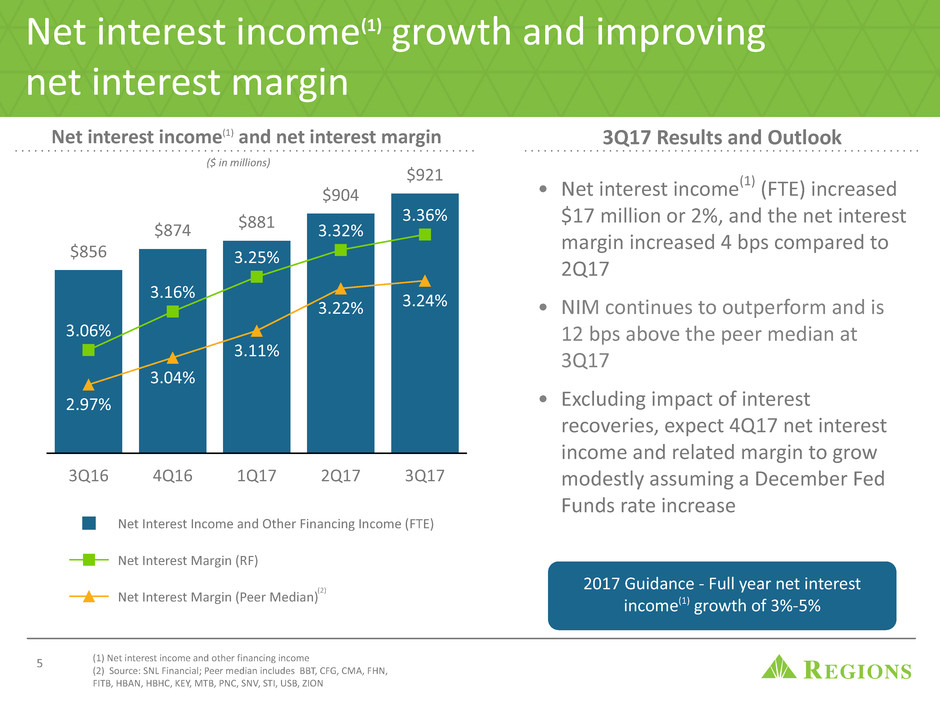
Net interest income(1) growth and improving
net interest margin
Net Interest Income and Other Financing Income (FTE)
Net Interest Margin (RF)
Net Interest Margin (Peer Median)
3Q16 4Q16 1Q17 2Q17 3Q17
$856
$874 $881
$904
$921
3.06%
3.16%
3.25%
3.32%
3.36%
2.97%
3.04%
3.11%
3.22% 3.24%
• Net interest income(1) (FTE) increased
$17 million or 2%, and the net interest
margin increased 4 bps compared to
2Q17
• NIM continues to outperform and is
12 bps above the peer median at
3Q17
• Excluding impact of interest
recoveries, expect 4Q17 net interest
income and related margin to grow
modestly assuming a December Fed
Funds rate increase
($ in millions)
5
Net interest income(1) and net interest margin
(1) Net interest income and other financing income
(2) Source: SNL Financial; Peer median includes BBT, CFG, CMA, FHN,
FITB, HBAN, HBHC, KEY, MTB, PNC, SNV, STI, USB, ZION
3Q17 Results and Outlook
2017 Guidance - Full year net interest
income(1) growth of 3%-5%
(2)
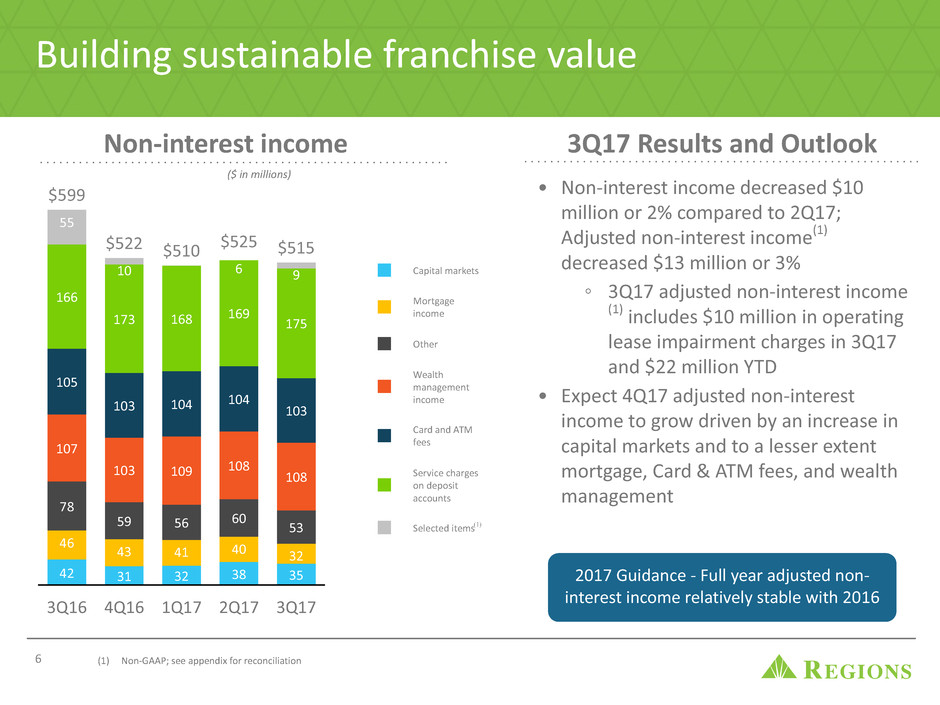
Non-interest income
Capital markets
Mortgage
income
Other
Wealth
management
income
Card and ATM
fees
Service charges
on deposit
accounts
Selected items
3Q16 4Q16 1Q17 2Q17 3Q17
42 31 32 38 35
46 43 41 40 32
78
59 56 60 53
107
103 109 108 108
105
103 104 104 103
166
173 168
$510
169
175
55
$599
10
$522
6
$525
9
$515
Building sustainable franchise value
(1) Non-GAAP; see appendix for reconciliation
($ in millions)
6
• Non-interest income decreased $10
million or 2% compared to 2Q17;
Adjusted non-interest income(1)
decreased $13 million or 3%
◦ 3Q17 adjusted non-interest income
(1) includes $10 million in operating
lease impairment charges in 3Q17
and $22 million YTD
• Expect 4Q17 adjusted non-interest
income to grow driven by an increase in
capital markets and to a lesser extent
mortgage, Card & ATM fees, and wealth
management
2017 Guidance - Full year adjusted non-
interest income relatively stable with 2016
3Q17 Results and Outlook
(1)

Non-interest expenses
Prudently managing expenses
3Q16 4Q16 1Q17 2Q17 3Q17
912
877 872 899 880
22
$934
22
$899
5
$877 10
$909
6
$886
65.3%
63.2%
62.7%
63.2%
61.7%
(1) Non-GAAP; see appendix for reconciliation
($ in millions)
Selected Items(1)Adjusted Non-Interest Expense(1)
7
• Non-interest expense decreased $23 million or
3% compared to 2Q17; adjusted non-interest
expense(1) decreased $19 million or 2%
◦ Salaries and benefits decreased $14
million or 3% primarily due to reduced
pension settlement charges and lower
health insurance costs
◦ Professional fees decreased $7 million
due to lower legal and consulting costs
◦ Declines partially offset by a $5 million
increase in occupancy and a $7 million
increase in other real estate owned
expenses driven by recent hurricanes
• Adjusted efficiency ratio(1) decreased 150 bps
to 61.7%
3Q17 Results and Outlook
2017 Expectations: Full year adjusted non-interest expense
growth of 0%-1%; full-year adjusted efficiency ratio ~62% and
adjusted operating leverage of ~2%
Adjusted efficiency ratio(1)
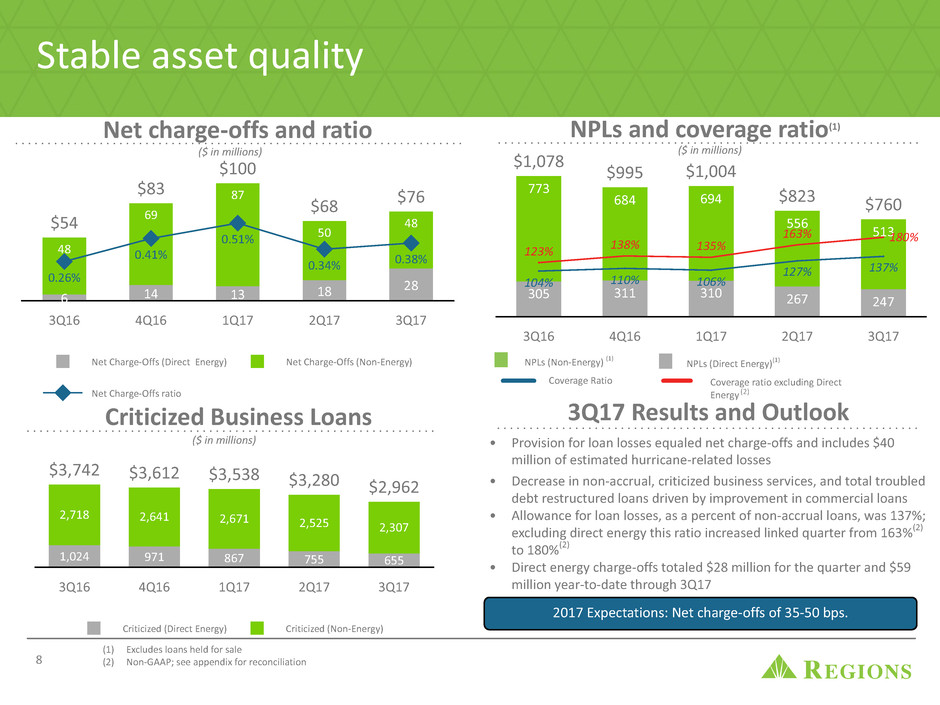
NPLs and coverage ratio(1)
Criticized (Direct Energy) Criticized (Non-Energy)
3Q16 4Q16 1Q17 2Q17 3Q17
1,024 971 867 755 655
2,718
$3,742
2,641
$3,612
2,671
$3,538
2,525
$3,280
2,307
$2,962
Net Charge-Offs (Direct Energy) Net Charge-Offs (Non-Energy)
Net Charge-Offs ratio
3Q16 4Q16 1Q17 2Q17 3Q17
6 14 13 18
28
48
$54 69
$83 87
$100
50
$68
48
$76
0.26%
0.41%
0.51%
0.34% 0.38%
3Q16 4Q16 1Q17 2Q17 3Q17
305 311 310 267 247
773
$1,078
684
$995
694
$1,004
556
$823
513
$760
104% 110% 106%
127% 137%
123% 138% 135%
163% 180%
Stable asset quality
• Provision for loan losses equaled net charge-offs and includes $40
million of estimated hurricane-related losses
• Decrease in non-accrual, criticized business services, and total troubled
debt restructured loans driven by improvement in commercial loans
• Allowance for loan losses, as a percent of non-accrual loans, was 137%;
excluding direct energy this ratio increased linked quarter from 163%(2)
to 180%(2)
• Direct energy charge-offs totaled $28 million for the quarter and $59
million year-to-date through 3Q17
($ in millions) ($ in millions)
8
3Q17 Results and Outlook
(1) Excludes loans held for sale
(2) Non-GAAP; see appendix for reconciliation
Net charge-offs and ratio
(2)
Criticized Business Loans
($ in millions)
Coverage ratio excluding Direct
Energy
NPLs (Non-Energy) (1)
Coverage Ratio
NPLs (Direct Energy)(1)
2017 Expectations: Net charge-offs of 35-50 bps.

Average loans and leases
Business Lending Consumer Lending
3Q16 4Q16 1Q17 2Q17 3Q17
$50.2 $49.1 49.0 49.0 48.3
$31.1
$81.3
$31.5
$80.6
31.2
$80.2
31.1
$80.1
31.3
$79.6
Prudently managing loans
($ in billions)
9
• Total new and renewed loan production
remained solid up 9% compared to 3Q16
including business lending production up 15%;
however elevated loan payoffs and pay downs
drove a decline in total average balances
• Average consumer lending portfolio increased
$180 million compared to 2Q17
• Average business lending portfolio decreased
$705 million compared to 2Q17
• Current loan pipelines are higher than they
have been all year
• Expect 4Q17 loan growth on an end to end
basis
3Q17 Results and Outlook
2017 Guidance - Excluding the impact of exiting the third-party
indirect-vehicle portfolio, full year average loans are expected
to be down slightly compared to the prior year
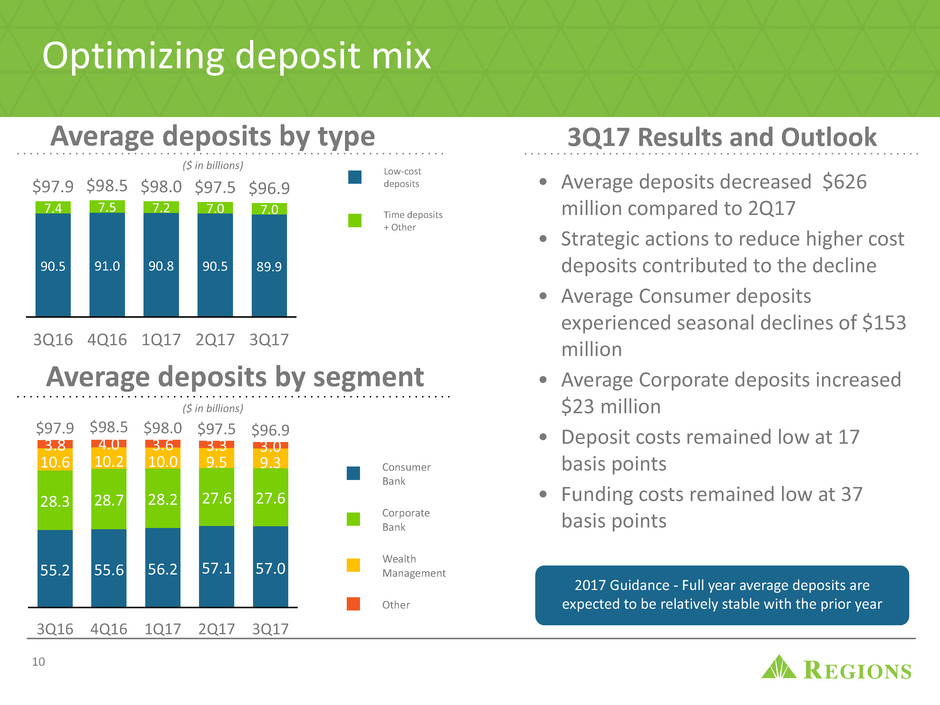
Average deposits by segment
Consumer
Bank
Corporate
Bank
Wealth
Management
Other
3Q16 4Q16 1Q17 2Q17 3Q17
55.2 55.6 56.2 57.1 57.0
28.3 28.7 28.2 27.6 27.6
10.6 10.2 10.0 9.5 9.3
3.8
$97.9
4.0
$98.5
3.6
$98.0
3.3
$97.5
3.0
$96.9
Average deposits by type
Optimizing deposit mix
Low-cost
deposits
Time deposits
+ Other
3Q16 4Q16 1Q17 2Q17 3Q17
90.5 91.0 90.8 90.5 89.9
7.4
$97.9
7.5
$98.5
7.2
$98.0
7.0
$97.5
7.0
$96.9
($ in billions)
10
($ in billions)
• Average deposits decreased $626
million compared to 2Q17
• Strategic actions to reduce higher cost
deposits contributed to the decline
• Average Consumer deposits
experienced seasonal declines of $153
million
• Average Corporate deposits increased
$23 million
• Deposit costs remained low at 17
basis points
• Funding costs remained low at 37
basis points
3Q17 Results and Outlook
2017 Guidance - Full year average deposits are
expected to be relatively stable with the prior year

$57
$8
$28
$3
3Q16 4Q16 1Q17 2Q17 3Q17
18 18 19 19 19
17
$35
18
$36
17
$36
17
$36
18
$37
Interest Bearing Deposits
by Customer Type(1)
($ in billions)
Non-Interest Bearing Deposits
by Customer Type(1)
($ in billions)
Other
Segment
Deposit advantage
Deposits by Customer Type(1)
(Retail vs. Business)
• Retail deposits consist of consumer and private wealth
accounts and represent 67% of total deposits
• Business deposits consist of corporate, institutional and
other accounts and represent 33% of total deposits
• 38% of total average 3Q17 deposits are non-interest
bearing deposits
• Approximately 43% of our consumer low-cost deposit
dollars have been customers for over 10 years
• Deposit MSA stratification
◦ ~50% of deposits <1M people
◦ ~35% of deposits <500K people
• Low loan-to-deposit ratio of 81% at 3Q17
3Q16 4Q16 1Q17 2Q17 3Q17
44 45 46 45 45
19
$63
17
$62
16
$62
16
$61
15
$60
11
Consumer
Segment
Private
Wealth*
Corporate
Segment
Institutional
Trust*
$1
* Private Wealth and Institutional Trust deposits are combined into the Wealth Management Segment.
(1) Average Balances
3Q17 ($ in billions)

Deposit composition and pricing
(as of September 30, 2017)
• Regions' predominantly deposit funded balance sheet, which includes an attractive mix of low cost deposits, provides for
a competitive funding advantage against the peer set
◦ 91% of liability funding is comprised of deposits, the second highest in the peer group
◦ 34% of liability funding is in non-interest bearing accounts, the third highest in the peer group
• This advantage is evidenced in the current rising rate cycle through Regions' 11% deposit beta to date versus the peer
median of 15.5%
Interest bearing deposit betas Deposit funding composition
Peers include: BBT, CFG, CMA, FHN, FITB, HBAN, HBHC, KEY, MTB, PNC, SNV, STI, USB, ZION
Source: SNL Financial12
Peer median = 15.5%
Peer median = 4.8b
ps
Peer median = 86%
Peer median = 26%
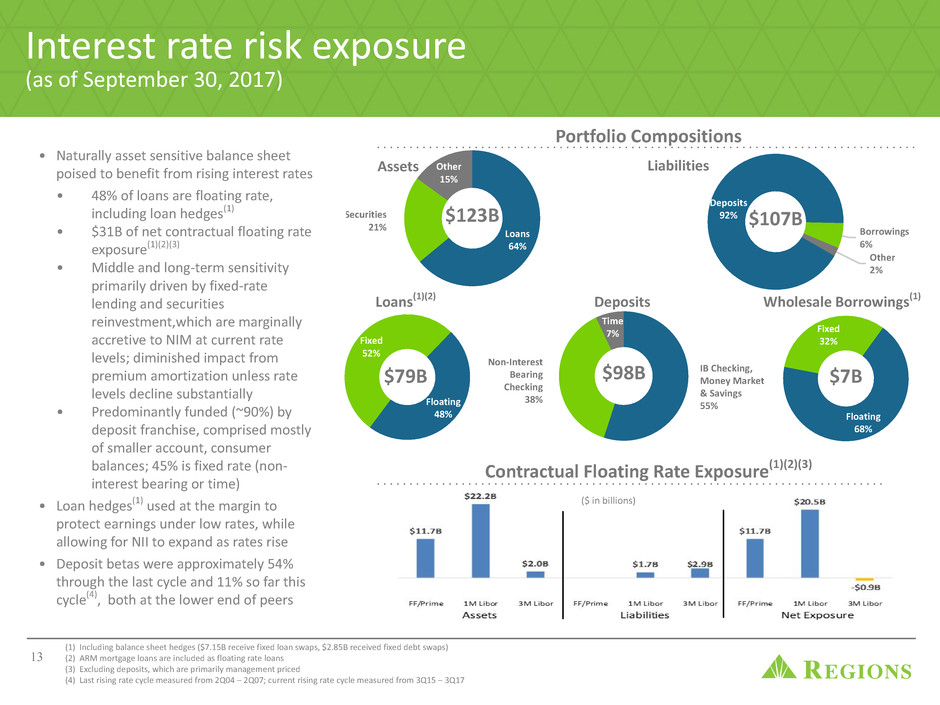
Loans
64%
Securities
21%
Other
15%
Deposits
92%
Borrowings
6%
Other
2%
Floating
48%
Fixed
52%
IB Checking,
Money Market
& Savings
55%
Non-Interest
Bearing
Checking
38%
Time
7%
Floating
68%
Fixed
32%
Wholesale Borrowings(1)DepositsLoans(1)(2)
Assets Liabilities
$123B
$79B
$107B
$98B $7B
Portfolio Compositions
Contractual Floating Rate Exposure(1)(2)(3)
• Naturally asset sensitive balance sheet
poised to benefit from rising interest rates
• 48% of loans are floating rate,
including loan hedges(1)
• $31B of net contractual floating rate
exposure(1)(2)(3)
• Middle and long-term sensitivity
primarily driven by fixed-rate
lending and securities
reinvestment,which are marginally
accretive to NIM at current rate
levels; diminished impact from
premium amortization unless rate
levels decline substantially
• Predominantly funded (~90%) by
deposit franchise, comprised mostly
of smaller account, consumer
balances; 45% is fixed rate (non-
interest bearing or time)
• Loan hedges(1) used at the margin to
protect earnings under low rates, while
allowing for NII to expand as rates rise
• Deposit betas were approximately 54%
through the last cycle and 11% so far this
cycle(4), both at the lower end of peers
(1) Including balance sheet hedges ($7.15B receive fixed loan swaps, $2.85B received fixed debt swaps)
(2) ARM mortgage loans are included as floating rate loans
(3) Excluding deposits, which are primarily management priced
(4) Last rising rate cycle measured from 2Q04 – 2Q07; current rising rate cycle measured from 3Q15 – 3Q17
Interest rate risk exposure
(as of September 30, 2017)
($ in billions)
13

Assumption Sensitivity Analysis (2)(3)
($ in millions)
Standard Interest Rate Risk Scenario Assumptions
Interest rate risk assumptions
(as of September 30, 2017)
(1) Growth expectations exclude the impact of third-party indirect-vehicle portfolio
(2) Impacts of stresses to standard shock scenario are applied independently; not cumulative
(3) Including balance sheet hedges ($7.15B receive fixed loan swaps, $2.85B received fixed debt swaps)
14

Strong capital levels
Note: Regions’ and peer CET1 ratios are as of 9/30/17. Peers includes BBT, CFG, CMA, FHN, FITB, HBAN, HBHC, KEY, MTB, PNC, SNV, STI, USB and ZION.
Source: SNL Financial15
Basel III Common Equity Tier 1 Ratio
Peer #1
Peer #2
RF
Peer #3
Peer #4
Peer #5
Peer #6
Peer #7
Peer #8
Peer #9
Peer #10
Peer #11
Peer #12
Peer #13
Peer #14
12.2
11.5
11.3
11.1
11.0
10.6
10.3
10.3
10.1
10.1
10.0
10.0
9.9
9.6
9.6
Capital Priorities
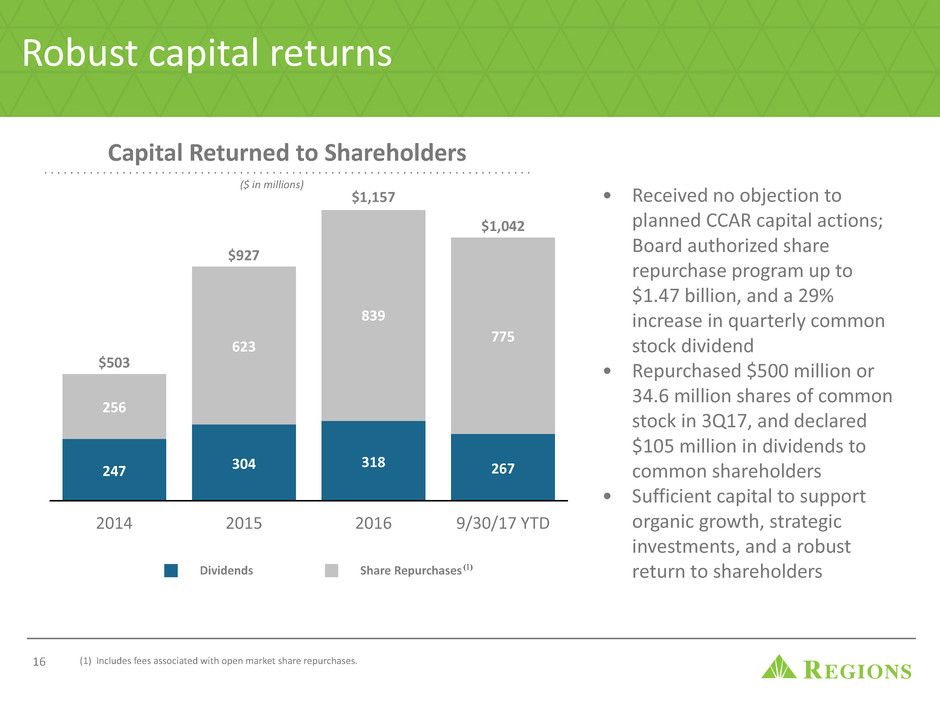
Capital Returned to Shareholders
Dividends Share Repurchases
2014 2015 2016 9/30/17 YTD
247 304 318 267
256
$503
623
$927
839
$1,157
775
$1,042
Robust capital returns
(1) Includes fees associated with open market share repurchases.16
• Received no objection to
planned CCAR capital actions;
Board authorized share
repurchase program up to
$1.47 billion, and a 29%
increase in quarterly common
stock dividend
• Repurchased $500 million or
34.6 million shares of common
stock in 3Q17, and declared
$105 million in dividends to
common shareholders
• Sufficient capital to support
organic growth, strategic
investments, and a robust
return to shareholders
($ in millions)
(1)
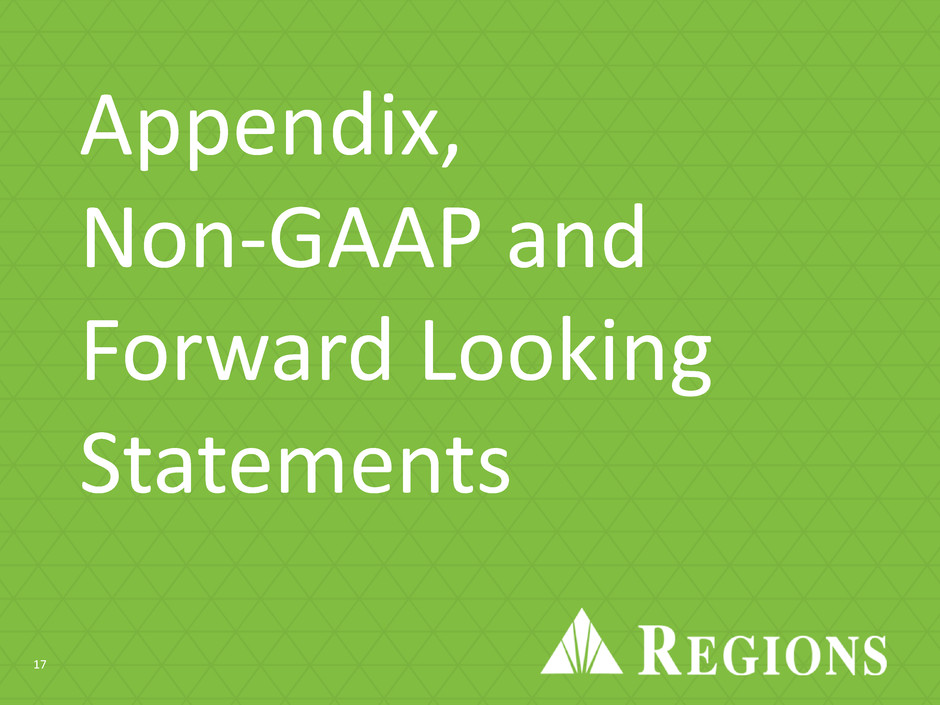
Appendix,
Non-GAAP and
Forward Looking
Statements
17
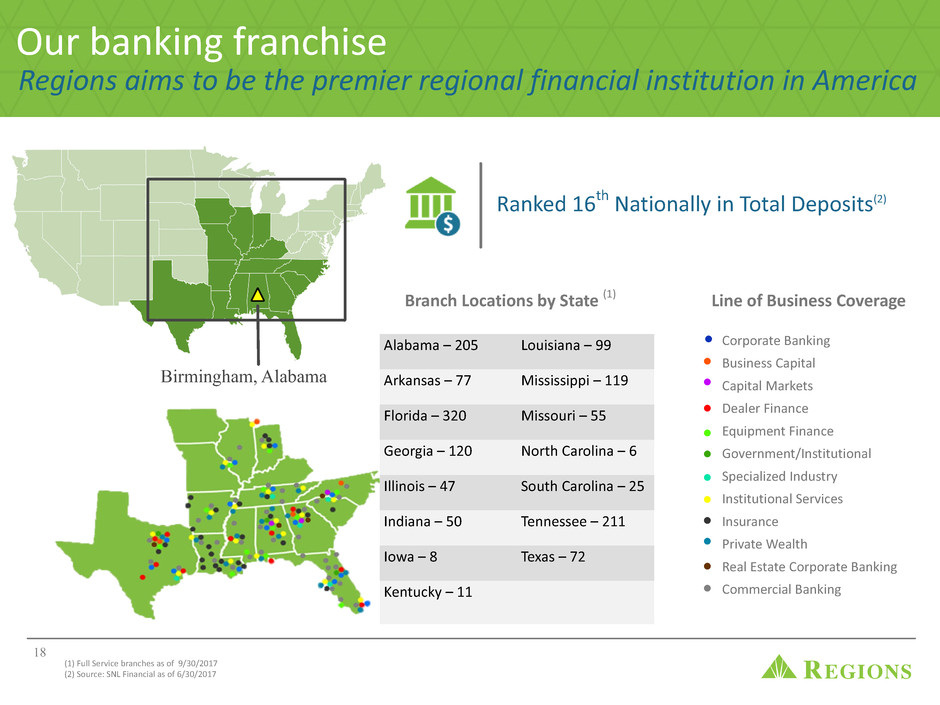
Regions aims to be the premier regional financial institution in America
Line of Business Coverage
Alabama – 205 Louisiana – 99
Arkansas – 77 Mississippi – 119
Florida – 320 Missouri – 55
Georgia – 120 North Carolina – 6
Illinois – 47 South Carolina – 25
Indiana – 50 Tennessee – 211
Iowa – 8 Texas – 72
Kentucky – 11
Ranked 16th Nationally in Total Deposits(2)
Corporate Banking
Business Capital
Capital Markets
Dealer Finance
Equipment Finance
Government/Institutional
Specialized Industry
Institutional Services
Insurance
Private Wealth
Real Estate Corporate Banking
Commercial Banking
•
•
•
•
•
•
•
•
•
•
•
•
Branch Locations by State (1)
Our banking franchise
Birmingham, Alabama
(1) Full Service branches as of 9/30/2017
(2) Source: SNL Financial as of 6/30/2017
18

Strength of our markets
19
Market Share Rank in Core States
80% of total deposits are in our core states
Alabama - Mississippi - Florida
Louisiana - Tennessee - Arkansas
80%
Market Share in Top Markets
Source: SNL Financial
As of 6/30/2017 FDIC summary
Regions Branches
Regions Insurance Group
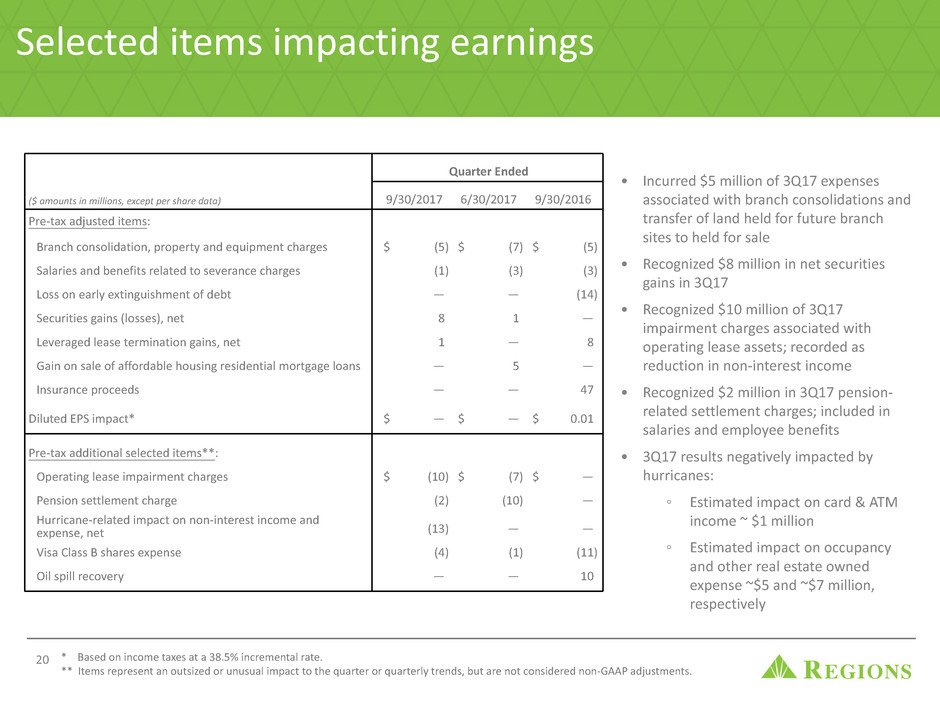
Quarter Ended
($ amounts in millions, except per share data) 9/30/2017 6/30/2017 9/30/2016
Pre-tax adjusted items:
Branch consolidation, property and equipment charges $ (5) $ (7) $ (5)
Salaries and benefits related to severance charges (1) (3) (3)
Loss on early extinguishment of debt — — (14)
Securities gains (losses), net 8 1 —
Leveraged lease termination gains, net 1 — 8
Gain on sale of affordable housing residential mortgage loans — 5 —
Insurance proceeds — — 47
Diluted EPS impact* $ — $ — $ 0.01
Pre-tax additional selected items**:
Operating lease impairment charges $ (10) $ (7) $ —
Pension settlement charge (2) (10) —
Hurricane-related impact on non-interest income and
expense, net (13) — —
Visa Class B shares expense (4) (1) (11)
Oil spill recovery — — 10
• Incurred $5 million of 3Q17 expenses
associated with branch consolidations and
transfer of land held for future branch
sites to held for sale
• Recognized $8 million in net securities
gains in 3Q17
• Recognized $10 million of 3Q17
impairment charges associated with
operating lease assets; recorded as
reduction in non-interest income
• Recognized $2 million in 3Q17 pension-
related settlement charges; included in
salaries and employee benefits
• 3Q17 results negatively impacted by
hurricanes:
◦ Estimated impact on card & ATM
income ~ $1 million
◦ Estimated impact on occupancy
and other real estate owned
expense ~$5 and ~$7 million,
respectively
* Based on income taxes at a 38.5% incremental rate.
** Items represent an outsized or unusual impact to the quarter or quarterly trends, but are not considered non-GAAP adjustments.
20
Selected items impacting earnings

2017 expectations
21
• Excluding the impact of the third-party indirect-vehicle portfolio, full year average loans
are expected to be down slightly compared to the prior year
• Full year average deposits are expected to be relatively stable with the prior year
• Net interest income and other financing income growth of 3%-5%
• Adjusted non-interest income relatively stable with the prior year*
• Adjusted expenses 0%-1%; adjusted efficiency ratio ~62%*
• Adjusted operating leverage of ~2%*
• Effective tax rate expected in the 30%-31% range
• Net charge-offs of 35-50 bps
* The reconciliation with respect to these forward-looking non-GAAP measures is expected to be consistent with actual non-GAAP reconciliations
included in appendix.
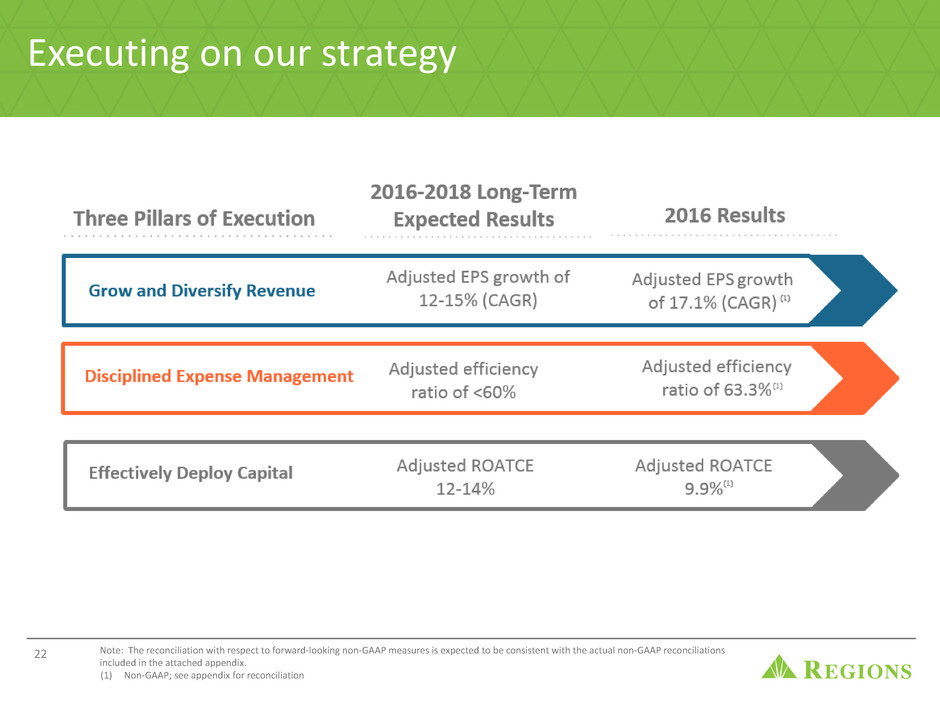
Executing on our strategy
22 Note: The reconciliation with respect to forward-looking non-GAAP measures is expected to be consistent with the actual non-GAAP reconciliations
included in the attached appendix.
(1) Non-GAAP; see appendix for reconciliation

Commercial retail lending overview
Total retail
(1) Does not include $26 million of retail related operating leases.
* Represents the number of clients with loan balances outstanding.23
As of 9/30/17
($ in millions)
Loan
Balances
Total
Commitments
Including
Outstanding
Balances
%
Utilization
$
Criticized
%
Criticized
# of
Clients *
REITs
$1,451 $2,776 52% — — 27
Investor real
estate (IRE) 956 1,034 92% 14 1% 318
C&I
1,236 2,393 52% 45 4% 7,310
CRE-OO
637 669 95% 30 5% 1,278
Asset Based
Lending 682 1,695 40% 41 6% 25
Total Retail(1)
$4,962 $8,567 58% $130 3% 8,958
• Approximately $200 million of outstanding balances across the REIT
and IRE portfolios relate to shopping malls
• Portfolio exposure to REITs specializing in enclosed malls consists of a
small number of credits, all of which are investment grade
• IRE portfolio is widely distributed, largest tenants typically include
'basic needs' anchors
• C&I retail portfolio is also widely distributed; largest categories
include:
◦ Motor vehicle & parts dealers ~$380 million outstanding to
~1,100 clients
◦ Building materials, garden equipment & supplies ~$160
million outstanding to ~700 clients
◦ Non-store retailers ~$175 million outstanding to ~270 clients
◦ Less than $60 million outstanding to clothing & accessories
• CRE-OO portfolio consists primarily of small strip malls and
convenience stores
• Asset Based Lending portfolio is collateralized primarily by inventory
and accounts receivable
• Generally, well-placed retail centers continue to perform well with low
vacancy rates
• Regions has not been impacted by recent big name bankruptcies;
continue to watch the sector closely
• Securities portfolio (not included on this slide) includes ~$792 million
of post-crisis issued AAA rated CMBS with exposure to retail within
the diversified collateral pool; protected with 35% credit
enhancement, and losses expected to be de minimis in severely
adverse scenario; portfolio also includes ~$70 million in retail related
high quality, investment grade corporate bonds

Energy lending overview
Total energy
As of 9/30/17 As of 6/30/17
($ in millions)
Loan /
Lease
Balances
Total
Commitments
Including
Outstanding
Balances
%
Utilization
$
Criticized
%
Criticized
Loan /
Lease
Balances
Total
Commitments
Including
Outstanding
Balances
%
Utilization
$
Criticized
%
Criticized
Oilfield services
and supply (OFS) $513 $758 68% $274 53% $601 $926 65% $335 56%
Exploration and
production
(E&P) 699 1,330 53% 354 51% 678 1,261 54% 388 57%
Midstream 524 1,225 43% 12 2% 519 1,188 44% 13 3%
Downstream 72 277 26% 15 21 81 299 27% 16 20%
Other 94 234 40% — —% 106 287 37% 3 3
Total direct
1,902 3,824 50% 655 34% 1,985 3,961 50% 755 38%
Indirect 572 935 61% 112 20% 544 994 55% 103 19%
Direct and
indirect 2,474 4,759 52% 767 31% 2,529 4,955 51% 858 34%
Operating leases
66 66 — 28 42% 97 97 — 58 60%
Loans held for
sale 1 1 — 1 100% 1 1 — 1 100%
Total energy $2,541 $4,826 53% $796 31% $2,627 $5,053 52% $917 35%
Note: Securities portfolio contained ~$3MM of high quality, investment grade corporate bonds that are energy related at 9/30/17, down $1mm from 6/30/17.
A leveraged relationship is defined as senior cash flow leverage of 3x or total cash flow leverage of 4x except for Midstream Energy which is 6x total cash flow
leverage.
(1) Non-GAAP; see appendix for reconciliation
24
• Total outstandings and commitments
declined primarily due to paydowns
and payoffs
• Allowance for loan and lease losses
was 6.1% of direct energy balances at
9/30/17 vs 6.9% at 6/30/17
• No second lien exposure outstanding
within the energy portfolio
• Leveraged loans account for 30% of
energy related balances; the majority
are Exploration & Production and
Midstream
• Energy charge-offs were $28 million
for 3Q17 and $59 million for 2017
year to date
• Under a scenario with oil averaging
below $25, incremental losses could
total $100 million over the next 8
quarters
• Utilization rate has remained
between 40-60% since 1Q15
• 13% of direct energy loans are on
non-accrual status
• ALLL/NPL excluding direct energy is
180%(1)
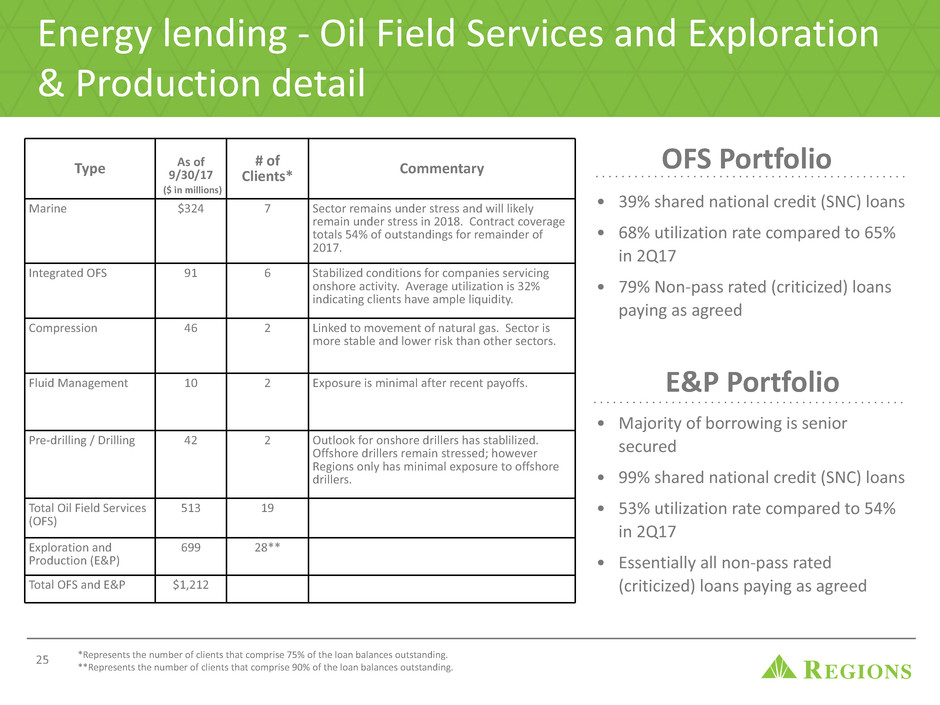
Energy lending - Oil Field Services and Exploration
& Production detail
Type As of9/30/17
# of
Clients* Commentary
Marine $324 7 Sector remains under stress and will likely
remain under stress in 2018. Contract coverage
totals 54% of outstandings for remainder of
2017.
Integrated OFS 91 6 Stabilized conditions for companies servicing
onshore activity. Average utilization is 32%
indicating clients have ample liquidity.
Compression 46 2 Linked to movement of natural gas. Sector is
more stable and lower risk than other sectors.
Fluid Management 10 2 Exposure is minimal after recent payoffs.
Pre-drilling / Drilling 42 2 Outlook for onshore drillers has stablilized.
Offshore drillers remain stressed; however
Regions only has minimal exposure to offshore
drillers.
Total Oil Field Services
(OFS)
513 19
Exploration and
Production (E&P)
699 28**
Total OFS and E&P $1,212
E&P Portfolio
*Represents the number of clients that comprise 75% of the loan balances outstanding.
**Represents the number of clients that comprise 90% of the loan balances outstanding.
OFS Portfolio
($ in millions)
25
• 39% shared national credit (SNC) loans
• 68% utilization rate compared to 65%
in 2Q17
• 79% Non-pass rated (criticized) loans
paying as agreed
• Majority of borrowing is senior
secured
• 99% shared national credit (SNC) loans
• 53% utilization rate compared to 54%
in 2Q17
• Essentially all non-pass rated
(criticized) loans paying as agreed

Commercial -
Non-Energy,
$2,211
Investor Real
Estate, $134
Consumer Real
Estate Secured,
$1,145
Consumer Non-Real Estate
Secured, $292
Commercial - Energy
(Direct), $378
Loan balances by select states
As of September 30, 2017
Texas Louisiana
Commercial - Non-
Energy, $4,288
Investor Real
Estate, $984
Consumer Real Estate
Secured, $1,163
Consumer Non-Real Estate
Secured, $1,013
Commercial - Energy
(Direct), $1,043
Investor Real Estate
($ in millions)
Office Retail Multi-Family
Single
Family Other Total
Houston $43 $43 $188 $74 $20 $368
Dallas 106 31 113 62 30 342
San
Antonio — 26 25 16 17 84
Other 9 75 95 4 7 190
Total $158 $175 $421 $156 $174 $984
Investor Real Estate
($ in millions)
Office Retail Multi-Family
Single
Family Other Total
Baton
Rouge $34 $1 $9 $9 $10 $63
New
Orleans 4 5 1 1 5 16
Other 5 4 30 1 15 55
Total $43 $10 $40 $11 $30 $134
$4.2B$8.5B
26

Loan balances by select states (continued)
As of September 30, 2017
Alabama Mississippi
Commercial - Non-
Energy, $4,866
Investor Real Estate,
$270
Consumer Real
Estate Secured,
$3,577
Consumer Non-Real Estate
Secured, $807
Commercial -
Non-Energy,
$1,454
Investor Real
Estate, $131
Consumer Real
Estate Secured,
$927
Consumer Non-Real Estate
Secured, $356
Commercial -
Energy (Direct),
$26
$2.9B$9.5B
Investor Real Estate
($ in millions)
Office Retail Multi-
Family
Single
Family
Other Total
Birmingham $16 $21 $6 $14 $19 $76
Huntsville 81 15 5 4 1 106
Mobile /
Baldwin County 2 15 3 1 17 38
Other 7 9 17 9 8 50
Total $106 $60 $31 $28 $45 $270
Investor Real Estate
($ in millions)
Office Retail Multi-Family
Single
Family Other Total
North
Mississippi — — — — $79 $79
Jackson/Other 4 4 21 1 3 33
Gulfport /
Biloxi /
Pascagoula — — 18 — 1 19
Total $4 $4 $39 $1 $83 $131
Commercial- Energy
(Direct), $18
27
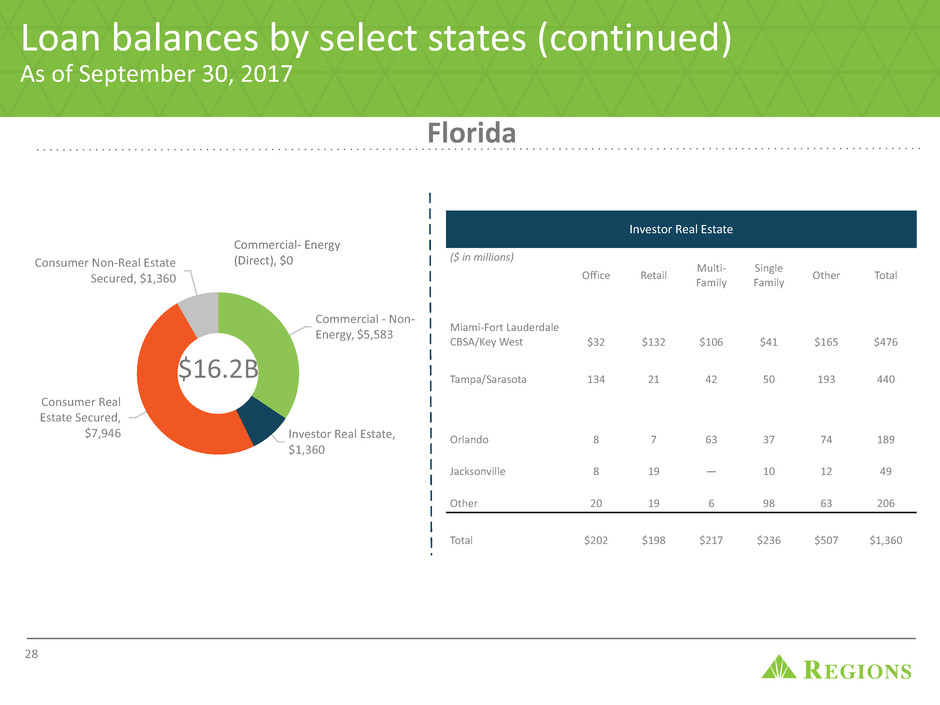
Loan balances by select states (continued)
As of September 30, 2017
Commercial - Non-
Energy, $5,583
Investor Real Estate,
$1,360
Consumer Real
Estate Secured,
$7,946
Consumer Non-Real Estate
Secured, $1,360
Florida
Investor Real Estate
($ in millions)
Office Retail Multi-Family
Single
Family Other Total
Miami-Fort Lauderdale
CBSA/Key West $32 $132 $106 $41 $165 $476
Tampa/Sarasota 134 21 42 50 193 440
Orlando 8 7 63 37 74 189
Jacksonville 8 19 — 10 12 49
Other 20 19 6 98 63 206
Total $202 $198 $217 $236 $507 $1,360
$16.2B
28
Commercial- Energy
(Direct), $0
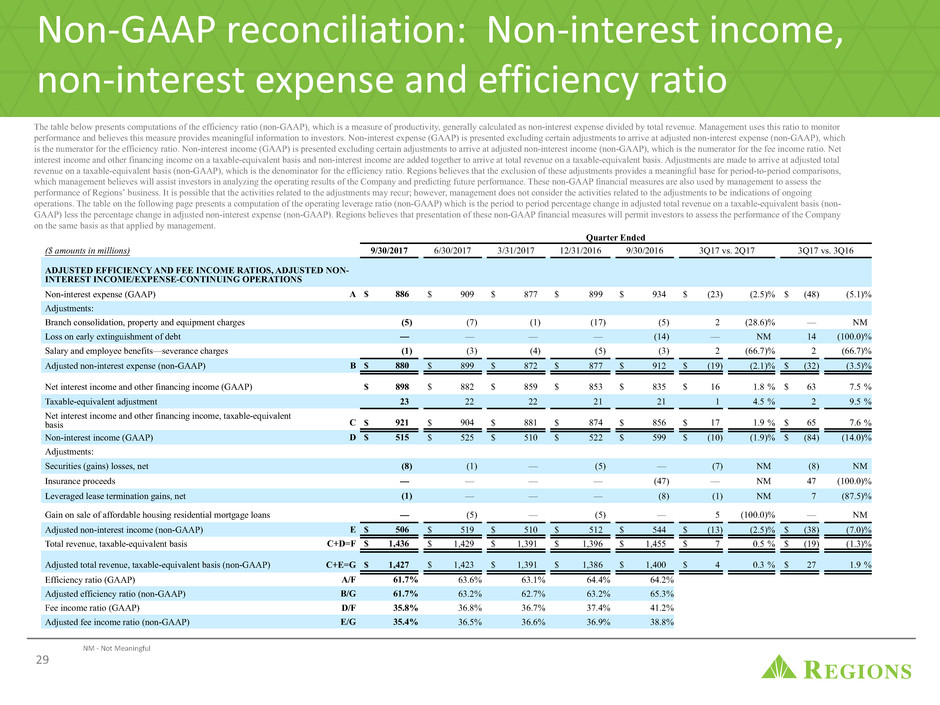
Non-GAAP reconciliation: Non-interest income,
non-interest expense and efficiency ratio
NM - Not Meaningful
The table below presents computations of the efficiency ratio (non-GAAP), which is a measure of productivity, generally calculated as non-interest expense divided by total revenue. Management uses this ratio to monitor
performance and believes this measure provides meaningful information to investors. Non-interest expense (GAAP) is presented excluding certain adjustments to arrive at adjusted non-interest expense (non-GAAP), which
is the numerator for the efficiency ratio. Non-interest income (GAAP) is presented excluding certain adjustments to arrive at adjusted non-interest income (non-GAAP), which is the numerator for the fee income ratio. Net
interest income and other financing income on a taxable-equivalent basis and non-interest income are added together to arrive at total revenue on a taxable-equivalent basis. Adjustments are made to arrive at adjusted total
revenue on a taxable-equivalent basis (non-GAAP), which is the denominator for the efficiency ratio. Regions believes that the exclusion of these adjustments provides a meaningful base for period-to-period comparisons,
which management believes will assist investors in analyzing the operating results of the Company and predicting future performance. These non-GAAP financial measures are also used by management to assess the
performance of Regions’ business. It is possible that the activities related to the adjustments may recur; however, management does not consider the activities related to the adjustments to be indications of ongoing
operations. The table on the following page presents a computation of the operating leverage ratio (non-GAAP) which is the period to period percentage change in adjusted total revenue on a taxable-equivalent basis (non-
GAAP) less the percentage change in adjusted non-interest expense (non-GAAP). Regions believes that presentation of these non-GAAP financial measures will permit investors to assess the performance of the Company
on the same basis as that applied by management.
29
Quarter Ended
($ amounts in millions) 9/30/2017 6/30/2017 3/31/2017 12/31/2016 9/30/2016 3Q17 vs. 2Q17 3Q17 vs. 3Q16
ADJUSTED EFFICIENCY AND FEE INCOME RATIOS, ADJUSTED NON-
INTEREST INCOME/EXPENSE-CONTINUING OPERATIONS
Non-interest expense (GAAP) A $ 886 $ 909 $ 877 $ 899 $ 934 $ (23) (2.5)% $ (48) (5.1)%
Adjustments:
Branch consolidation, property and equipment charges (5) (7) (1) (17) (5) 2 (28.6)% — NM
Loss on early extinguishment of debt — — — — (14) — NM 14 (100.0)%
Salary and employee benefits—severance charges (1) (3) (4) (5) (3) 2 (66.7)% 2 (66.7)%
Adjusted non-interest expense (non-GAAP) B $ 880 $ 899 $ 872 $ 877 $ 912 $ (19) (2.1)% $ (32) (3.5)%
Net interest income and other financing income (GAAP) $ 898 $ 882 $ 859 $ 853 $ 835 $ 16 1.8 % $ 63 7.5 %
Taxable-equivalent adjustment 23 22 22 21 21 1 4.5 % 2 9.5 %
Net interest income and other financing income, taxable-equivalent
basis C $ 921 $ 904 $ 881 $ 874 $ 856 $ 17 1.9 % $ 65 7.6 %
Non-interest income (GAAP) D $ 515 $ 525 $ 510 $ 522 $ 599 $ (10) (1.9)% $ (84) (14.0)%
Adjustments:
Securities (gains) losses, net (8) (1) — (5) — (7) NM (8) NM
Insurance proceeds — — — — (47) — NM 47 (100.0)%
Leveraged lease termination gains, net (1) — — — (8) (1) NM 7 (87.5)%
Gain on sale of affordable housing residential mortgage loans — (5) — (5) — 5 (100.0)% — NM
Adjusted non-interest income (non-GAAP) E $ 506 $ 519 $ 510 $ 512 $ 544 $ (13) (2.5)% $ (38) (7.0)%
Total revenue, taxable-equivalent basis C+D=F $ 1,436 $ 1,429 $ 1,391 $ 1,396 $ 1,455 $ 7 0.5 % $ (19) (1.3)%
Adjusted total revenue, taxable-equivalent basis (non-GAAP) C+E=G $ 1,427 $ 1,423 $ 1,391 $ 1,386 $ 1,400 $ 4 0.3 % $ 27 1.9 %
Efficiency ratio (GAAP) A/F 61.7% 63.6% 63.1% 64.4% 64.2%
Adjusted efficiency ratio (non-GAAP) B/G 61.7% 63.2% 62.7% 63.2% 65.3%
Fee income ratio (GAAP) D/F 35.8% 36.8% 36.7% 37.4% 41.2%
Adjusted fee income ratio (non-GAAP) E/G 35.4% 36.5% 36.6% 36.9% 38.8%

Non-GAAP reconciliation continued: Non-interest
income, non-interest expense and efficiency ratio
NM - Not Meaningful
30
Nine Months Ended September 30
($ amounts in millions) 2017 2016 2017 vs. 2016
ADJUSTED EFFICIENCY, FEE INCOME AND OPERATING LEVERAGE RATIOS, ADJUSTED NON-INTEREST INCOME/
EXPENSE- CONTINUING OPERATIONS
Non-interest expense (GAAP) H $ 2,672 $ 2,718 $ (46) (1.7)%
Adjustments:
Professional, legal and regulatory expenses — (3) 3 (100.0)%
Branch consolidation, property and equipment charges (13) (41) 28 (68.3)%
Loss on early extinguishment of debt — (14) 14 (100.0)%
Salary and employee benefits—severance charges (8) (16) 8 (50.0)%
Adjusted non-interest expense (non-GAAP) I $ 2,651 $ 2,644 $ 7 0.3 %
Net interest income and other financing income (GAAP) $ 2,639 $ 2,545 $ 94 3.7 %
Taxable-equivalent adjustment 67 63 4 6.3 %
Net interest income and other financing income, taxable-equivalent basis J $ 2,706 $ 2,608 $ 98 3.8 %
Non-interest income (GAAP) K $ 1,550 $ 1,631 $ (81) (5.0)%
Adjustments:
Securities (gains) losses, net (9) (1) (8) NM
Insurance proceeds — (50) 50 (100.0)%
Leveraged lease termination gains, net (1) (8) 7 (87.5)%
Gain on sale of affordable housing residential mortgage loans (5) — (5) NM
Adjusted non-interest income (non-GAAP) L $ 1,535 $ 1,572 $ (37) (2.4)%
Total revenue, taxable-equivalent basis J+K=M $ 4,256 $ 4,239 $ 17 0.4 %
Adjusted total revenue, taxable-equivalent basis (non-GAAP) J+L=N $ 4,241 $ 4,180 $ 61 1.5 %
Operating leverage ratio (GAAP) M-H 2.1 %
Adjusted operating leverage ratio (non-GAAP) N-I 1.2 %
Efficiency ratio (GAAP) H/M 62.8% 64.1%
Adjusted efficiency ratio (non-GAAP) I/N 62.5% 63.3%
Fee income ratio (GAAP) K/M 36.4% 38.5%
Adjusted fee income ratio (non-GAAP) L/N 36.2% 37.6%

Non-GAAP reconciliation: pre-tax pre-provision
income
Pre-Tax Pre-Provision Income ("PPI") and Adjusted PPI (non-GAAP)
The Pre-Tax Pre-Provision Income table below presents computations of pre-tax pre-provision income from continuing operations excluding certain adjustments (non-GAAP). Regions believes that the
presentation of PPI and the exclusion of certain items from PPI provides a meaningful base for period-to-period comparisons, which management believes will assist investors in analyzing the
operating results of the Company and predicting future performance. These non-GAAP financial measures are also used by management to assess the performance of Regions’ business. It is possible
that the activities related to the adjustments may recur; however, management does not consider the activities related to the adjustments to be indications of ongoing operations. Regions believes
that presentation of these non-GAAP financial measures will permit investors to assess the performance of the Company on the same basis as that applied by management. Non-GAAP financial
measures have inherent limitations, are not required to be uniformly applied and are not audited. Although these non-GAAP financial measures are frequently used by stakeholders in the evaluation
of a company, they have limitations as analytical tools, and should not be considered in isolation, or as a substitute for analyses of results as reported under GAAP. In particular, a measure of income
that excludes certain adjustments does not represent the amount that effectively accrues directly to stockholders.
Quarter Ended
($ amounts in millions) 9/30/2017 6/30/2017 3/31/2017 12/31/2016 9/30/2016 3Q17 vs. 2Q17 3Q17 vs. 3Q16
Net income from continuing operations available to common shareholders (GAAP) $ 296 $ 301 $ 278 $ 278 $ 303 $ (5) (1.7)% $ (7) (2.3)%
Preferred dividends (GAAP) 16 16 16 16 16 — NM — NM
Income tax expense (GAAP) 139 133 128 134 152 6 4.5 % (13) (8.6)%
Income from continuing operations before income taxes (GAAP) 451 450 422 428 471 1 0.2 % (20) (4.2)%
Provision for loan losses (GAAP) 76 48 70 48 29 28 58.3 % 47 162.1 %
Pre-tax pre-provision income from continuing operations (non-GAAP) 527 498 492 476 500 29 5.8 % 27 5.4 %
Other adjustments:
Gain on sale of affordable housing residential mortgage loans — (5) — (5) — 5 (100.0)% — NM
Securities (gains) losses, net (8) (1) — (5) — (7) NM (8) NM
Insurance proceeds — — — — (47) — NM 47 (100.0)%
Leveraged lease termination gains, net (1) — — — (8) (1) NM 7 (87.5)%
Salaries and employee benefits—severance charges 1 3 4 5 3 (2) (66.7)% (2) (66.7)%
Branch consolidation, property and equipment charges 5 7 1 17 5 (2) (28.6)% — NM
Loss on early extinguishment of debt — — — — 14 — NM (14) (100.0)%
Total other adjustments (3) 4 5 12 (33) (7) (175.0)% 30 (90.9)%
Adjusted pre-tax pre-provision income from continuing operations (non-
GAAP) $ 524 $ 502 $ 497 $ 488 $ 467 $ 22 4.4 % $ 57 12.2 %
31 NM - Not Meaningful

The table below presents computations of the adjusted allowance for loan losses to non-performing loans, excluding loans held for sale ratio (non-GAAP), generally calculated as adjusted allowance for
loan losses divided by adjusted total non-accrual loans, excluding loans held for sale. The allowance for loan losses (GAAP) is presented excluding the portion of the allowance related to direct energy
loans to arrive at the adjusted allowance for loan losses (non-GAAP). Total non-accrual loans (GAAP) is presented excluding direct energy non-accrual loans to arrive at adjusted total non-accrual loans,
excluding loans held for sale (non-GAAP), which is the denominator for the allowance for loan losses to non-accrual loans ratio. Management believes that excluding the portion of the allowance for
loan losses related to direct energy loans and the direct energy non-accrual loans will assist investors in analyzing the Company's credit quality performance absent the volatility that has been
experienced by energy businesses. Non-GAAP financial measures have inherent limitations, are not required to be uniformly applied, are not audited, and should not be considered in isolation, or as a
substitute for analyses of results as reported under GAAP.
Non-GAAP reconciliation: Adjusted allowance for loan losses to
non-performing loans, excluding loans held for sale
32
As of
($ amounts in millions) 9/30/2017 6/30/2017 3/31/2017 12/31/2016 9/30/2016
Allowance for loan losses (GAAP) $ 1,041 $ 1,041 $ 1,061 $ 1,091 $ 1,126
Less: Direct energy portion 115 136 123 147 176
Adjusted allowance for loan losses (non-GAAP) $ 926 $ 905 $ 938 $ 944 $ 950
Total non-accrual loans (GAAP) $ 760 $ 823 $ 1,004 $ 995 $ 1,078
Less: Direct energy non-accrual loans 247 267 310 311 305
Adjusted total non-accrual loans (non-GAAP) $ 513 $ 556 $ 694 $ 684 $ 773
Allowance for loan losses to non-performing loans, excluding loans held for sale (GAAP) 1.37x 1.27x 1.06x 1.10x 1.04x
Adjusted allowance for loan losses to non-performing loans, excluding loans held for sale (non-GAAP) 1.80x 1.63x 1.35x 1.38x 1.23x

Non-GAAP reconciliation: YTD return on average tangible stockholders'
equity and earnings per common share from continuing operations
The tables below present computations of "adjusted net income from continuing operations available to common shareholders," "adjusted return on average
tangible common stockholders' equity" and "adjusted earnings per common share from continuing operations," which exclude certain significant items that are
included in the financial results presented in accordance with GAAP. Management believes these measures provide a meaningful base for period-to-period
comparisons, and will assist investors in analyzing the operating results of the Company and predicting future performance. These non-GAAP financial
measures are also used by management to assess the performance of Regions’ business. It is possible that the activities related to the adjustments may recur;
however, management does not consider the activities related to the adjustments to be indications of ongoing operations. Regions believes that presentation of
these non-GAAP financial measures will permit investors to assess the performance of the Company on the same basis as that applied by management. These
non-GAAP measures also provide analysts and investors certain metrics regarding the progress of the Company in comparison to long-term expected results
previously communicated.
(1) Refer to the non-GAAP reconciliation on page 45 of Regions’ Annual Report on Form 10-K for the year ended December 31, 2016, as filed with the SEC.
(2) The computation of the income tax impact for adjusted items is based on 38.5%, comprised of the statutory federal rate of 35%, adjusted for applicable state income taxes, net
of the related federal tax benefit. The tax adjustment also includes the tax impact from leveraged lease termination gains.
(3) On a continuing operations basis.
33
Year ended December 31
($ amounts in millions) 2016 2015 2016 vs. 2015
ADJUSTED RETURN ON AVERAGE TANGIBLE COMMON STOCKHOLDERS' EQUITY
Net income from continuing operations available to common shareholders (GAAP) A $ 1,094 $ 1,011 $ 83 8.2 %
Total net adjustments to non-interest expense(1) 96 153 (57) (37.3)%
Total net adjustments to non-interest income(1) (69) (128) 59 (46.1)%
Income tax adjustment(2) (2) (28) 26 (92.9)%
Adjusted net income from continuing operations available to common shareholders (non-GAAP) B $ 1,119 $ 1,008 $ 111 11.0 %
Average stockholders' equity (GAAP) $ 17,126 $ 16,916 $ 210 1.2 %
Less: Average intangible assets (GAAP) 5,125 5,099 26 0.5 %
Average deferred tax liability related to intangibles (GAAP) (162) (170) 8 (4.7)%
Average preferred stock (GAAP) 820 848 (28) (3.3)%
Average tangible common stockholders' equity (non-GAAP) C $ 11,343 $ 11,139 $ 204 1.8 %
Return on average tangible common stockholders' equity (non-GAAP)(3) A/C 9.65% 9.07%
Adjusted return on average tangible common stockholders' equity (non-GAAP)(3) B/C 9.87% 9.04%
ADJUSTED EARNINGS PER COMMMON SHARE
Weighted average number of shares outstanding (diluted) D 1,261 1,334
Earnings per common share from continuing operations (GAAP) A/D $ 0.87 $ 0.76 $ 0.11 14.5 %
Adjusted earnings per common share from continuing operations (non-GAAP) B/D $ 0.89 $ 0.76 $ 0.13 17.1 %

Forward-looking statements
This presentation may include forward-looking statements as defined in the Private Securities Litigation Reform Act of 1995. The terms “Regions,” the “Company,” “we,” “us” and “our” mean Regions Financial Corporation, a Delaware
corporation, and its subsidiaries when or where appropriate. The words “anticipates,” “intends,” “plans,” “seeks,” “believes,” “estimates,” “expects,” “targets,” “projects,” “outlook,” “forecast,” “will,” “may,” “could,” “should,” “can,” and similar
expressions often signify forward-looking statements. Forward-looking statements are not based on historical information, but rather are related to future operations, strategies, financial results or other developments. Forward-looking
statements are based on management’s current expectations as well as certain assumptions and estimates made by, and information available to, management at the time the statements are made. Those statements are based on general
assumptions and are subject to various risks, and because they also relate to the future they are likewise subject to inherent uncertainties and other factors that may cause actual results to differ materially from the views, beliefs and
projections expressed in such statements. Therefore, we caution you against relying on any of these forward-looking statements. These risks, uncertainties and other factors include, but are not limited to, those described below:
• Current and future economic and market conditions in the United States generally or in the communities we serve, including the effects of declines in property values, unemployment rates and potential reductions of economic growth, which
may adversely affect our lending and other businesses and our financial results and conditions.
• Possible changes in trade, monetary and fiscal policies of, and other activities undertaken by, governments, agencies, central banks and similar organizations, which could have a material adverse effect on our earnings.
• The effects of a possible downgrade in the U.S. government’s sovereign credit rating or outlook, which could result in risks to us and general economic conditions that we are not able to predict.
• Possible changes in market interest rates or capital markets could adversely affect our revenue and expense, the value of assets and obligations, and the availability and cost of capital and liquidity.
• Any impairment of our goodwill or other intangibles, or any adjustment of valuation allowances on our deferred tax assets due to adverse changes in the economic environment, declining operations of the reporting unit, or other factors.
• Possible changes in the creditworthiness of customers and the possible impairment of the collectability of loans and leases, including operating leases.
• Changes in the speed of loan prepayments, loan origination and sale volumes, charge-offs, loan loss provisions or actual loan losses where our allowance for loan losses may not be adequate to cover our eventual losses.
• Possible acceleration of prepayments on mortgage-backed securities due to low interest rates, and the related acceleration of premium amortization on those securities.
• Our ability to effectively compete with other financial services companies, some of whom possess greater financial resources than we do and are subject to different regulatory standards than we are.
• Loss of customer checking and savings account deposits as customers pursue other, higher-yield investments, which could increase our funding costs.
• Our inability to develop and gain acceptance from current and prospective customers for new products and services in a timely manner could have a negative impact on our revenue.
• The effects of any developments, changes or actions relating to any litigation or regulatory proceedings brought against us or any of our subsidiaries.
• Changes in laws and regulations affecting our businesses, such as the Dodd-Frank Act and other legislation and regulations relating to bank products and services, as well as changes in the enforcement and interpretation of such laws and regulations
by applicable governmental and self-regulatory agencies, which could require us to change certain business practices, increase compliance risk, reduce our revenue, impose additional costs on us, or otherwise negatively affect our businesses.
• Our ability to obtain a regulatory non-objection (as part of the CCAR process or otherwise) to take certain capital actions, including paying dividends and any plans to increase common stock dividends, repurchase common stock under current
or future programs, or redeem preferred stock or other regulatory capital instruments, may impact our ability to return capital to stockholders and market perceptions of us.
• Our ability to comply with stress testing and capital planning requirements (as part of the CCAR process or otherwise) may continue to require a significant investment of our managerial resources due to the importance and intensity of such tests
and requirements.
• Our ability to comply with applicable capital and liquidity requirements (including, among other things, the Basel III capital standards and the LCR rule), including our ability to generate capital internally or raise capital on favorable terms, and if
we fail to meet requirements, our financial condition could be negatively impacted.
• The Basel III framework calls for additional risk-based capital surcharges for globally systemically important banks. Although we are not subject to such surcharges, it is possible that in the future we may become subject to similar surcharges.
• The costs, including possibly incurring fines, penalties, or other negative effects (including reputational harm) of any adverse judicial, administrative, or arbitral rulings or proceedings, regulatory enforcement actions, or other legal actions to
which we or any of our subsidiaries are a party, and which may adversely affect our results.
• Our ability to manage fluctuations in the value of assets and liabilities and off-balance sheet exposure so as to maintain sufficient capital and liquidity to support our business.
34

Our ability to execute on our strategic and operational plans, including our ability to fully realize the financial and non-financial benefits relating to our strategic initiatives.
• The success of our marketing efforts in attracting and retaining customers.
• Possible changes in consumer and business spending and saving habits and the related effect on our ability to increase assets and to attract deposits, which could adversely affect our net income.
• Our ability to recruit and retain talented and experienced personnel to assist in the development, management and operation of our products and services may be affected by changes in laws and regulations in effect from time to time.
• Fraud or misconduct by our customers, employees or business partners.
• Any inaccurate or incomplete information provided to us by our customers or counterparties.
• The risks and uncertainties related to our acquisition and integration of other companies.
• Inability of our framework to manage risks associated with our business such as credit risk and operational risk, including third-party vendors and other service providers, which could, among other things, result in a breach of operating or
security systems as a result of a cyber attack or similar act.
• The inability of our internal disclosure controls and procedures to prevent, detect or mitigate any material errors or fraudulent acts.
• The effects of geopolitical instability, including wars, conflicts and terrorist attacks and the potential impact, directly or indirectly, on our businesses.
• The effects of man-made and natural disasters, including fires, floods, droughts, tornadoes, hurricanes, and environmental damage, which may negatively affect our operations and/or our loan portfolios and increase our cost of conducting
business.
• Changes in commodity market prices and conditions could adversely affect the cash flows of our borrowers operating in industries that are impacted by changes in commodity prices (including businesses indirectly impacted by commodities
prices such as businesses that transport commodities or manufacture equipment used in the production of commodities), which could impair their ability to service any loans outstanding to them and/or reduce demand for loans in those
industries.
• Our inability to keep pace with technological changes could result in losing business to competitors.
• Our ability to identify and address cyber-security risks such as data security breaches, “denial of service” attacks, malware, “hacking” and identity theft, a failure of which could disrupt our business and result in the disclosure of and/or misuse
or misappropriation of confidential or proprietary information; disruption or damage to our systems; increased costs; losses; or adverse effects to our reputation.
• Our ability to realize our adjusted efficiency ratio target as part of our expense management initiatives.
• Significant disruption of, or loss of public confidence in, the Internet and services and devices used to access the Internet could affect the ability of our customers to access their accounts and conduct banking transactions.
• Possible downgrades in our credit ratings or outlook could increase the costs of funding from capital markets.
• The effects of problems encountered by other financial institutions that adversely affect us or the banking industry generally could require us to change certain business practices, reduce our revenue, impose additional costs on us, or otherwise
negatively affect our businesses.
• The effects of the failure of any component of our business infrastructure provided by a third party could disrupt our businesses; result in the disclosure of and/or misuse of confidential information or proprietary information; increase our costs;
negatively affect our reputation; and cause losses.
• Our ability to receive dividends from our subsidiaries could affect our liquidity and ability to pay dividends to stockholders.
• Changes in accounting policies or procedures as may be required by the FASB or other regulatory agencies could materially affect how we report our financial results.
• Other risks identified from time to time in reports that we file with the SEC.
• The effects of any damage to our reputation resulting from developments related to any of the items identified above.
The foregoing list of factors is not exhaustive. For discussion of these and other factors that may cause actual results to differ from expectations, look under the captions “Forward-Looking Statements” and “Risk Factors” of Regions’ Annual Report
on Form 10-K for the year ended December 31, 2016, as filed with the SEC.
The words “anticipates,” “intends,” “plans,” “seeks,” “believes,” “estimates,” “expects,” “targets,” “projects,” “outlook,” “forecast,” “will,” “may,” “could,” “should,” “can,” and similar expressions often signify forward-looking statements. You should
not place undue reliance on any forward-looking statements, which speak only as of the date made. We assume no obligation to update or revise any forward-looking statements that are made from time to time.
Regions’ Investor Relations contact is Dana Nolan at (205) 264-7040; Regions’ Media contact is Evelyn Mitchell at (205) 264-4551.
Forward-looking statements continued
35

®
36
